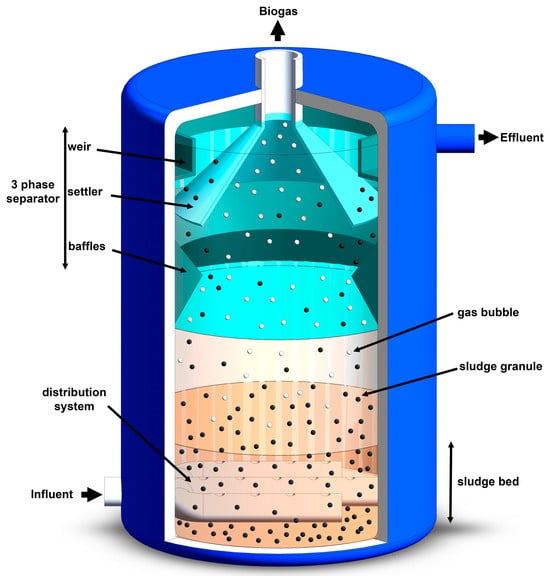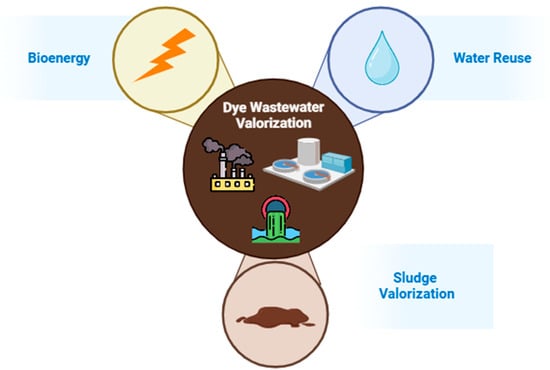
| Version | Summary | Created by | Modification | Content Size | Created at | Operation |
|---|---|---|---|---|---|---|
| 1 | Ronei de Almeida | -- | 2295 | 2023-11-27 10:35:07 | | | |
| 2 | Lindsay Dong | Meta information modification | 2295 | 2023-11-28 09:00:18 | | |
Video Upload Options
Dye-containing effluent generated in textile industries is polluting and complex wastewater. It should be managed adequately before its final destination. The up-flow anaerobic blanket (UASB) reactor application is an ecofriendly and cost-competitive treatment.
1. Introduction
2. Up-Flow Anaerobic Sludge Blanket Reactors

3. Mechanisms and Influencing Parameters in Textile Decolorization in UASB Reactors
3.1. Mechanisms of Dye Removal
3.2. Influence Parameters of Dye Removal
4. UASB Reactor’s Performance in Treating Dye-Containing Effluents
In decolorization studies, color and COD are commonly employed as monitoring parameters to evaluate the performance of UASB reactors. The operating conditions are similar to those previously discussed in the literature when treating diverse wastewaters. The treatability results demonstrate a range of color removal efficiencies from 50% to 97% and COD-removal efficiencies from 60% to 90%. All the reported findings are based on lab-scale investigations, necessitating further full-scale research to validate the outcomes in full-scale plants.
Bahia et al. [23] used an integrated UASB–shallow pound system in continuous feeding, achieving color and COD removal rates of 50% and 80%. Saleem et al. [24] combined UASB with a sequencing batch reactor (SBR) in an intermittent regime, resulting in higher removal rates of 87.7% for color and 90.4% for COD. These studies highlight how the feeding mode can significantly impact UASB efficiency.
However, anaerobic treatment alone may not fully break down dye byproducts such as polyaromatic amines. As in those studies, aerobic systems were integrated with UASB to address this issue. Aerobes can utilize oxygen and introduce hydroxyl groups into polyaromatic compounds at aerobic conditions. This step is essential in facilitating subsequent biodegradation pathways. Consequently, the aerobic process acts as a polishing step, effectively completing the mineralization of intermediates that arise from the anaerobic biotransformation. This completion occurs through hydroxylation or cleavage of the ring using oxidative enzymes such as laccase, phenoloxidase, and peroxidase [25]. On the other hand, amine byproducts have substituents with nitro and sulfonic groups, hampering their mineralization in an aerobic environment.
5. Dye-Wastewater Valorization

5.1. Bioenergy Production
5.2. Reclaimed Water
5.3. Sludge Valorization
References
- Al-Tohamy, R.; Ali, S.S.; Li, F.; Okasha, K.M.; Mahmoud, Y.A.G.; Elsamahy, T.; Jiao, H.; Fu, Y.; Sun, J. A Critical Review on the Treatment of Dye-Containing Wastewater: Ecotoxicological and Health Concerns of Textile Dyes and Possible Remediation Approaches for Environmental Safety. Ecotoxicol. Environ. Saf. 2022, 231, 113160.
- Holkar, C.R.; Jadhav, A.J.; Pinjari, D.V.; Mahamuni, N.M.; Pandit, A.B. A Critical Review on Textile Wastewater Treatments: Possible Approaches. J. Environ. Manag. 2016, 182, 351–366.
- Tkaczyk-Wlizło, A.; Mitrowska, K.; Błądek, T. Quantification of Twenty Pharmacologically Active Dyes in Water Samples Using UPLC-MS/MS. Heliyon 2022, 8, e09331.
- Mariraj Mohan, S.; Swathi, T. A Review on Upflow Anaerobic Sludge Blanket Reactor: Factors Affecting Performance, Modification of Configuration and Its Derivatives. Water Environ. Res. 2022, 94, e1665.
- Pereira Silva, T.; Guimarães de Oliveira, M.; Marques Mourão, J.M.; Bezerra dos Santos, A.; Lopes Pereira, E. Monte Carlo-Based Model for Estimating Methane Generation Potential and Electric Energy Recovery in Swine Wastewater Treated in UASB Systems. J. Water Process Eng. 2023, 51, 103399.
- Alcaraz-Ibarra, S.; Mier-Quiroga, M.A.; Esparza-Soto, M.; Lucero-Chávez, M.; Fall, C. Treatment of Chocolate-Processing Industry Wastewater in a Low-Temperature Pilot-Scale UASB: Reactor Performance and in-Situ Biogas Use for Bioenergy Recovery. Biomass Bioenergy 2020, 142, 105786.
- Arthur, P.M.A.; Konaté, Y.; Sawadogo, B.; Sagoe, G.; Dwumfour-Asare, B.; Ahmed, I.; Williams, M.N.V. Performance Evaluation of a Full-Scale Upflow Anaerobic Sludge Blanket Reactor Coupled with Trickling Filters for Municipal Wastewater Treatment in a Developing Country. Heliyon 2022, 8, e10129.
- Senthilkumar, M.; Gnanapragasam, G.; Arutchelvan, V.; Nagarajan, S. Treatment of Textile Dyeing Wastewater Using Two-Phase Pilot Plant UASB Reactor with Sago Wastewater as Co-Substrate. Chem. Eng. J. 2011, 166, 10–14.
- van Lier, J.B.; van der Zee, F.P.; Frijters, C.T.M.J.; Ersahin, M.E. Celebrating 40 Years Anaerobic Sludge Bed Reactors for Industrial Wastewater Treatment. Rev. Environ. Sci. Bio Technol. 2015, 14, 681–702.
- Haugen, F.; Bakke, R.; Lie, B.; Hovland, J.; Vasdal, K. Optimal Design and Operation of a UASB Reactor for Dairy Cattle Manure. Comput. Electron. Agric. 2015, 111, 203–213.
- Li, H.; Han, K.; Li, Z.; Zhang, J.; Li, H.; Huang, Y.; Shen, L.; Li, Q.; Wang, Y. Performance, Granule Conductivity and Microbial Community Analysis of Upflow Anaerobic Sludge Blanket (UASB) Reactors from Mesophilic to Thermophilic Operation. Biochem. Eng. J. 2018, 133, 59–65.
- Mainardis, M.; Buttazzoni, M.; Goi, D. Up-Flow Anaerobic Sludge Blanket (Uasb) Technology for Energy Recovery: A Review on State-of-the-Art and Recent Technological Advances. Bioengineering 2020, 7, 43.
- Shinde, R.; Hackula, A.; O’Shea, R.; Barth, S.; Murphy, J.D.; Wall, D.M. Demand-Driven Biogas Production from Upflow Anaerobic Sludge Blanket (UASB) Reactors to Balance the Power Grid. Bioresour. Technol. 2023, 385, 129364.
- Mirmohamadsadeghi, S.; Karimi, K.; Tabatabaei, M.; Aghbashlo, M. Biogas Production from Food Wastes: A Review on Recent Developments and Future Perspectives. Bioresour. Technol. Rep. 2019, 7, 100202.
- Mariraj Mohan, S.; Swathi, T. Enhanced Biogas Production and Substrate Degradation through the Intermittent Operation of Modified Upflow Anaerobic Sludge Blanket–Static Granular Bed Reactor Series. Water Environ. Res. 2022, 94, e10775.
- Liu, Y.; Xu, H.-L.; Yang, S.-F.; Tay, J.-H. Mechanisms and Models for Anaerobic Granulation in Upflow Anaerobic Sludge Blanket Reactor. Water Res. 2003, 37, 661–673.
- Hulshoff Pol, L.W.; de Castro Lopes, S.I.; Lettinga, G.; Lens, P.N.L. Anaerobic Sludge Granulation. Water Res. 2004, 38, 1376–1389.
- Show, K.-Y.; Yan, Y.; Yao, H.; Guo, H.; Li, T.; Show, D.-Y.; Chang, J.-S.; Lee, D.-J. Anaerobic Granulation: A Review of Granulation Hypotheses, Bioreactor Designs and Emerging Green Applications. Bioresour. Technol. 2020, 300, 122751.
- Gonzalez-Gutierrez, L.V.; Escamilla-Silva, E.M. Reactive Red Azo Dye Degradation in a UASB Bioreactor: Mechanism and Kinetics. Eng. Life Sci. 2009, 9, 311–316.
- Saratale, R.G.; Saratale, G.D.; Chang, J.S.; Govindwar, S.P. Bacterial Decolorization and Degradation of Azo Dyes: A Review. J. Taiwan Inst. Chem. Eng. 2011, 42, 138–157.
- de Almeida, R.; de Souza Guimarães, C. Up-Flow Anaerobic Sludge Blanket Reactors in Dye Removal: Mechanisms, Influence Factors, and Performance. In Biological Approaches in Dye-Containing Wastewater: Volume 1; Springer: Singapore, 2022; pp. 201–227. ISBN 9789811905452.
- van Haadel, A.; van der Lubbe, J. UASB Reactor Design Guidelines. In Anaerobic Sewage Treatment: Optimization of Process and Physical Design of Anaerobic and Complementary Processes; van Haandel, A., van der Lubbe, J., Eds.; IWA Publishing: London, UK, 2019; pp. 133–192. ISBN 9781780409627.
- Bahia, M.; Borges, T.A.; Passos, F.; de Aquino, S.F.; Silva, S.d.Q. Evaluation of a Combined System Based on an Upflow Anaerobic Sludge Blanket Reactor (UASB) and Shallow Polishing Pond (SPP) for Textile Effluent Treatment. Braz. Arch. Biol. Technol. 2020, 63, 1–8.
- Saleem, M.U.; Khan, S.J.; Shahzad, H.M.A.; Zeshan. Performance Evaluation of Integrated Anaerobic and Aerobic Reactors for Treatment of Real Textile Wastewater. Int. J. Environ. Sci. Technol. 2022, 19, 10325–10336.
- Albahnasawi, A.; Yüksel, E.; Gürbulak, E.; Duyum, F. Fate of Aromatic Amines through Decolorization of Real Textile Wastewater under Anoxic-Aerobic Membrane Bioreactor. J. Environ. Chem. Eng. 2020, 8, 104226.
- Varjani, S.; Rakholiya, P.; Shindhal, T.; Shah, A.V.; Ngo, H.H. Trends in Dye Industry Effluent Treatment and Recovery of Value Added Products. J. Water Process Eng. 2021, 39, 101734.
- Pavičić, J.; Novak Mavar, K.; Brkić, V.; Simon, K. Biogas and Biomethane Production and Usage: Technology Development, Advantages and Challenges in Europe. Energies 2022, 15, 2940.
- Gnanapragasam, G.; Senthilkumar, M.; Arutchelvan, V.; Sivarajan, P.; Nagarajan, S. Recycle in Upflow Anaerobic Sludge Blanket Reactor on Treatment of Real Textile Dye Effluent. World J. Microbiol. Biotechnol. 2010, 26, 1093–1098.
- Senthilkumar, M.; Arutchelvan, V.; Kanakasabai, V.; Venkatesh, K.R.; Nagarajan, S. Biomineralisation of Dye Waste in a Two-Phase Hybrid UASB Reactor Using Starch Effluent as a Co-Substrate. Int. J. Environ. Waste Manag. 2009, 3, 354.
- Volschan, I.; Cammarota, M.C.; De Almeida, R.; Lobato, L.C.S.; de Aquino, S.F. Part B: Sludge Sewage Pre-Treatment and Codigestion Technical Note 2—Contributions about Sewage Sludge Pre-Treatment Techniques. Cad. Técnicos Eng. Sanit. Ambient. 2022, 2, 13–22.
- Yang, H.; Dou, X.; Pan, F.; Wu, Q.; Li, C.; Zhou, B.; Hao, L. Optimal Planning of Local Biomass-Based Integrated Energy System Considering Anaerobic Co-Digestion. Appl. Energy 2022, 316, 119075.
- Chrispim, M.C.; Scholz, M.; Nolasco, M.A. Biogas Recovery for Sustainable Cities: A Critical Review of Enhancement Techniques and Key Local Conditions for Implementation. Sustain. Cities Soc. 2021, 72, 103033.
- Gadow, S.I.; Li, Y.-Y. Development of an Integrated Anaerobic/Aerobic Bioreactor for Biodegradation of Recalcitrant Azo Dye and Bioenergy Recovery: HRT Effects and Functional Resilience. Bioresour. Technol. Rep. 2020, 9, 100388.
- Gadow, S.I.; Estrada, A.L.; Li, Y.-Y. Characterization and Potential of Two Different Anaerobic Mixed Microflora for Bioenergy Recovery and Decolorization of Textile Wastewater: Effect of C/N Ratio, Dye Concentration and PH. Bioresour. Technol. Rep. 2022, 17, 100886.
- Shindhal, T.; Rakholiya, P.; Varjani, S.; Pandey, A.; Ngo, H.H.; Guo, W.; Ng, H.Y.; Taherzadeh, M.J. A Critical Review on Advances in the Practices and Perspectives for the Treatment of Dye Industry Wastewater. Bioengineered 2021, 12, 70–87.
- Yao, J.; Wen, D.; Shen, J.; Wang, J. Zero Discharge Process for Dyeing Wastewater Treatment. J. Water Process Eng. 2016, 11, 98–103.
- Erkanlı, M.; Yilmaz, L.; Çulfaz-Emecen, P.Z.; Yetis, U. Brackish Water Recovery from Reactive Dyeing Wastewater via Ultrafiltration. J. Clean. Prod. 2017, 165, 1204–1214.
- Khosravi, A.; Karimi, M.; Ebrahimi, H.; Fallah, N. Sequencing Batch Reactor/Nanofiltration Hybrid Method for Water Recovery from Textile Wastewater Contained Phthalocyanine Dye and Anionic Surfactant. J. Environ. Chem. Eng. 2020, 8, 103701.
- Gripa, E.; Dario, S.; Daflon, A.; De Almeida, R.; Valéria, F.; Campos, J.C. Landfill Leachate Treatment by High-Presssure Membranes and Advanced Oxidation Techniques with a Focus on Ecotoxicity and By-Products Management: A Review. Process Saf. Environ. Prot. 2023, 173, 747–764.
- Obotey Ezugbe, E.; Rathilal, S. Membrane Technologies in Wastewater Treatment: A Review. Membranes 2020, 10, 89.
- de Almeida, R.; de Souza Couto, J.M.; Gouvea, R.M.; de Almeida Oroski, F.; Bila, D.M.; Quintaes, B.R.; Campos, J.C. Nanofiltration Applied to the Landfill Leachate Treatment and Preliminary Cost Estimation. Waste Manag. Res. 2020, 38, 1119–1128.
- Cieślik, B.M.; Namieśnik, J.; Konieczka, P. Review of Sewage Sludge Management: Standards, Regulations and Analytical Methods. J. Clean. Prod. 2015, 90, 1–15.
- Bratina, B.; Šorgo, A.; Kramberger, J.; Ajdnik, U.; Zemljič, L.F.; Ekart, J.; Šafarič, R. From Municipal/Industrial Wastewater Sludge and FOG to Fertilizer: A Proposal for Economic Sustainable Sludge Management. J. Environ. Manag. 2016, 183, 1009–1025.
- Xiang, X.; Chen, X.; Dai, R.; Luo, Y.; Ma, P.; Ni, S.; Ma, C. Anaerobic Digestion of Recalcitrant Textile Dyeing Sludge with Alternative Pretreatment Strategies. Bioresour. Technol. 2016, 222, 252–260.
- Chen, X.; Xiang, X.; Dai, R.; Wang, Y.; Ma, P. Effect of Low Temperature of Thermal Pretreatment on Anaerobic Digestion of Textile Dyeing Sludge. Bioresour. Technol. 2017, 243, 426–432.
- Yildirir, E.; Ballice, L. Supercritical Water Gasification of Wet Sludge from Biological Treatment of Textile and Leather Industrial Wastewater. J. Supercrit. Fluids 2019, 146, 100–106.




